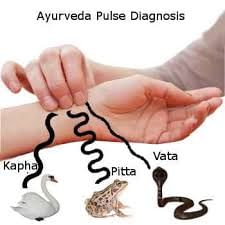Ayurvedic pulse diagnosis
What is nadi pariksha (ayurvedic pulse
Diagnosis)
This is the most powerful diagnostic tool for
Understanding the cause of any ailment or
Disease in the human body. It is a part of our
Vedic lineage and is passed on from guru to the
Disciple depending on the spiritual evolution of the
Disciple.
How is the diagnosis done
In the normal course of our visit to a doctor, we
Specify the ailments we feel we are suffering
From. Based on this preliminary information, the
Doctor checks us up and if necessary,
Recommends us to undergo further tests to
Collaborate his understanding with what we have
Told him. He thus forms an understanding of the
Symptoms.
On the contrary, during the nadi pariksha, a
Person need not have to specify his/her problems
In advance. The nadi vidwan is not supposed to
Know the details in advance as he should not get
Influenced by the patient's symptoms. Though
The symptoms reveal the disease process, it is
The cause of the prevailing or persisting
Symptoms that are more important. Each cell in
Our body possesses its own intelligence. It is the
Communication of this intelligence in the form of
Vibrations that is studied in nadi pariksha. Nadi
Pariksha understands the vibratory frequency of
The pulse at various levels on the radial artery.
Subtle vibrations are read at seven different levels
Vertically downward that help in ascertaining
Various functions in the body. The pulse, when
Examined, reveals both physical and mental
Characteristics of the pulse. This is interpreted in
The form of symptoms along with their prognosis
Which helps in understanding the cause. Thus,
Nadi pariksha forms the basis for addressing any
Ailment in an individual.
The accuracy of the pulse reading depends on the
Intuitive awareness of the individual and also the
Ability to understand and interpret the subtlety of
Vibrations. This sensitive awareness determines
The success of nadi pariksha.
The 5 elements or the 'panchamahabhutas' are
Ether, air, fire, water and earth. The 3 doshas or
Humors of vata, pitta, and kapha come as a
Combination of these 5 elements.
Ether + air = vata (mobility)
Fire +water = pitta (heat)
Water + earth = kapha (viscosity)
Any imbalance in the doshas will bring forth an
Ailment that will subsequently lead to a disease
Process. Each of these doshas have their
Physical, mental, emotional and physiological
Characteristics.
What is revealed during the nadi
Pariksha:
Every aspect of the human organism, the body,
Mind etc. Is understood during the pulse
Diagnosis.
Apart from understanding the cause of the
Current ailments, the diagnosis tracks the disease
Back to its origin. Even subtler levels of causal
Factors like emotional issues or specific thought
Patterns of the individual, that manifest into
Physical ailments subsequently are understood.
Nadi pariksha is undertaken to understand the
Following aspects in an individual:
Helps to ascertain one's original constitution at
The time of conception (prakruti). This forms the
Basis of deciding the basis and structure of the
Individualized healing process.
Helps to understand one's current constitution
As against the original constitution (vikruti).
The diagnosis ascertains the deviation that the
Body and mind have taken as compared to its
Original constitution. Also, it enables one to
Understand the prognosis of ailments that have
Arisen during this transition from prakruti to
Vikruti.
Nadi pariksha successfully tracks down the
Altered state of the mind. This is very important
As the science of ayurveda believes that a major
Part of human ailments are psychosomatic in
Nature. This is so because the only way the mind
Can express itself is through the body. Therefore,
The body works to a very large
Extent according to the dictates of the mind.
The analysis at the doshas, the subtle entities of
The psycho and physiological body. Any alteration in
The doshas can lead to understanding of the
Disease process. The doshas like vata, pitta
Kapha and their sub units help in understanding:
The movement of energies and the working of the
Nervous system, circulation as defined by the
Pulsation of the heart, and the movement of
Nutrition to various tissues in the body.
The metabolic process and the process of bio-
Transformation in the body, which governs the
Activities of digestion, absorption and assimilation
Of nutrition.
The assimilating and binding functions through
The help of bodily fluids which includes the
Proper and healthy formation of muscles, bones,
Ligaments and tendons etc.
The study of the health of various types of tissues
In the body like plasma, blood, muscle, marrow,
Bone, nerve, and reproduction.
The health of the chakras or the subtle energy
Wheels in the body that corresponds to the glands
In the physical body is ascertained. Chakras
Relate to and control certain physiological
Processes in the body.
Subsequent to doing the nadi pariksha, other
Forms of examination are taken up. This is done
To cross-examine the correctness of the pulse
Diagnosis. These various methods are highlighted
As under:
Nails - the shape and size of nails reveal the
Type of constitution a person belongs to. For
Example, small size nails with serrated edges
(basically bitten by a person due to anxiety or
Nervousness signifies a vata nail. Pitta nails are
Slightly larger in size with a slight curvature in the
Middle that resembles a semi 'c' shape. These
Nails, when pressed at the top, will reveal a slight
Yellow tinge in the center. A kapha nail is usually
Large in size. These nails normally will be whitish
In colour. The surface of the nail is usually large.
Indications: vata nails have vertical lines that
Look like deep serrations or ridges. Pitta nails,
Apart from having vertical ridges (not always
Necessary) can also have reddish lines along
These ridges starting from the bottom of the nail
Running towards the top. Kapha nails may have a
Larger curvature in the center owing to the larger
Surface area.
Tongue - the tongue reveals all the organs of
The body and particularly reveals the aspects of
Digestion and assimilation of food. It reveals the
Kind of digestive disorders and which of the 3
Doshas were responsible or are in a state of
Imbalance. The type of ailment is also revealed.
Indications: vata when aggravated shows a
Cracked and rough tongue. Pitta when aggravated
Shows a reddish tongue and kapha when
Aggravated shows a whitish slimy mucus coatin
On the tongue. The tongue also reveals the
Physiological problems present in other parts of
The body but this is a very lengthy subject and
Cannot be discussed in detail here.
2. Eyes - the shape of the eyes reveal the
Nature of the person's original constitution. Also
On examination, the eyes reveal what is the
Nature of the ailment and the doshas responsible
For it.
Indications: a person suffering from a vata
Disorder will have a brownish colouration in the
Eyes. There will be dryness felt in the eyes too. A
Pitta condition will reveal redness of yellowish
Colouring in the eyes. A kapha condition will show
Denseness or cloudy vision along with whitish
Marks in the eyes.
3. Speech - the strength of the voice and the
Intonations while talking reveals the predominant
Dosha present in the person at the time of
Examination. Also, which talking, gesticulations or
Emphasis during communication shows the
Predominant dosha at the time of analysis. This
Also reveals the nature of symptoms present in
The body and the cause.
Indications: a vata person will talk fast and will
Change subjects without relevance or context.
Breathing will be erratic and gesticulations will be
Predominant. A pitta person will speak in a loud,
Strong tone which will display dominance which
Can be easily mistaken for arrogance. The
Conviction in the speech will be evident. A kapha
Person will be mild, soft and musical in his
Speech. He will slow in his expressions and will
Not rush in his conversation.
4. Skin - the feel and texture of the skin reveals
The kind of dosha present. The temperature of
Skin reveals the presence of either vata, pitta and
Kapha in circulation. The pigmentation on the
Skin reveals the kind of toxins in the blood.
Indications: a vata skin is dry with scales or
Flaking. It will be cold to the touch. It can also
Have a darkish coloration. A pitta person will
Have an oily skin, with possible inflammation
Under the skin which will be denoted by reddish
Patches. It will be hot to the touch. Normally a
Pitta person will have a skin which will be hot to
The touch. A kapha person will have a cold and
Damp feeling to touch. It is either milkishly white
Or pale.
5. Urine - the colour, nature, frequency and the
Content in the urine determines the nature of
Ailment in the body. The frequency and the
Volume of urination reveals the intensity of
Ailment.
Indications: a vata person will experience scanty
Urination or infrequent urination. The quantity of
Urine will also vary. The urgency to urinate will
Not justify the quantity of urine coming out. The
Urine will be astringent in smell. A pitta person
Will have hot urine coming out and in a better
Volume. Normally, when the pitta dosha is
Aggravated, frequent, irritant urination will persist.
Urine will either be dark yellow to yellow to
Reddish in colour. The urine will have a strong and
Pungent smell. A kapha person will have a large
Volume of urination. The colour of urine will be
Whitish and can be frothy.
6. Stools - the formation and colour of stool
Shows the nature of the ailment. Also, the number of
Evacuations or lack of evacuation like
Constipation, for example, provides the information
Of both the emotional levels of the individual as
Well as the working of the physiological of the
Body. Even the smell in the breath when a
Person is talking reveals the kind of toxins
Present in the large intestine and the predominant
Dosha imbalance which has caused these toxins
To manifest.
Indications: a vata person will have varying stool
Formation. He will experience lots of gas and
Distention of the abdomen. Normally, stools will
Be hard and the person will feel constipated. The
Colour of the stools will vary between dark brown
To black. The stools will normally float. A pitta
Person will have well-formed stools too loose
Stools. The colour of the stools will vary from
Brown to light brown. Especially when the pitta
Dosha is aggravated, the stools colour will be
Yellowish in colour and can vary between semi
Formed to loose stools. He can also experience
Burning in his rectum while passing stools.
Occasional mucus formation will also be present.
A kapha person will have large volume in his
Stools. There will be mucus present in stools. The
Colour of stools will be between brown to yellow.



+1.svg)
